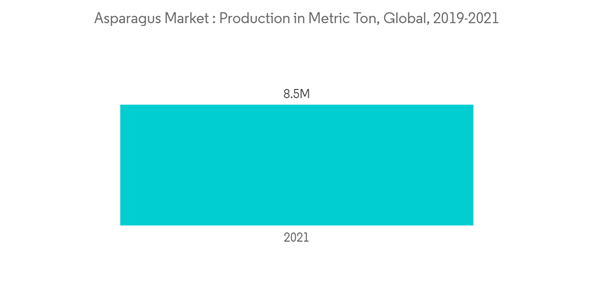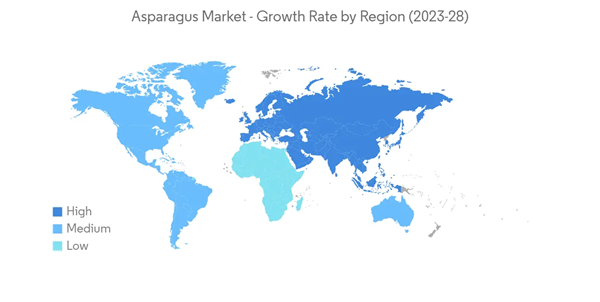Key Highlights
- Asparagus is a vegetable that belongs to the Asparagaceae family. There are more than 200 species within this plant family. Some species are grown as ornamental plants, and florists use others in corsages and arrangements. Asparagus is low in calories and a great source of nutrients, including folate, vitamins A, C, and K, and fiber.
- Additionally, asparagus provides many potential health benefits, including improved digestion, weight loss, lower blood pressure, and healthy pregnancy outcomes. It is one of the very few perennial vegetables that grow back year after year. It is an early-season crop that contributes to part-time and small-scale farming operations. Asparagus grows in temperate or subtropical climates in soils that are not too acidic. Thailand, Mexico, China, Peru, and Germany are the countries growing most of the world's asparagus.
- Furthermore, asparagus is actively sought by major companies as a key ingredient in soups on account of its nutritional properties and palatable taste. As a vegetable, asparagus is quite popular in preparing ready-to-eat foods, and asparagus is grated and mixed with other food products, such as mixed vegetables. Increasing demand for asparagus in fresh food products such as brine and pickled asparagus is likely to boost the revenue growth of the market studied.
- Moreover, government initiatives and increasing partnerships between significant producers in the market are projected to propel the market growth over the forecast period. For instance, in 2020, Applewood Fresh Growers LLC partnered with New Era's American Asparagus to offer fresh Michigan asparagus and its apples. Michigan is now the giant asparagus-growing region in the United States.
Asparagus Market Trends
Growing Demand for Asparagus Owing to its Various Health Benefits
Asparagus offers many health benefits, mainly because it contains several micronutrients. Asparagus contains glutathione and Rutin, which help as a cancer fighter and to strengthen blood vessels, respectively.Asparagus contains chromium, which helps insulin carry glucose into cells, and has the most folacin compared to any vegetable. Eating it can help prevent significant congenital disabilities of the baby's brain (anencephaly) and spine (spina bifida). It is also rich in fiber, which is linked to lower body weight and weight loss. Moreover, Asparagus can be used in several dishes like stir-fries, salads, omeletsAsparagus frittatas, and Asparagus. It can be cooked in Asparagus ways, including boiling, grilling, steaming, roasting, and sauteing.
Furthermore, increasing demand for asparagus is expected to drive the Asparagus market. The markets for various asparagus are dominated by North America and Europe, with the regions substantially increasing the import asAsparagusandroductionpastaic asparagus in recent years. Although organically organic asparagus markets are up, asparagus is at its nascent stage in Peru, the second-largest producer of asparagus in the world; the country is steadily raising its export-driven organic cultivation, as per the Peruvian Asparagus Importer's Association.
Moreover, several players and governments are taking initiatives to boost the production of Asparagus as there is a massive demand for Asparagus owing to its immense health benefits. For instance, according to FAO, the total production of Asparagus around the globe in 2019 was 8,415,420.9 metric ton, which increased and reached 8,501,442.93 metric ton in 2021.
Asia Pacific is Expected to Dominate the Market
Asparagus (Shatavari), is one of the most demanded vegetables in the region. It can be grown in most of the Asia pacific landscape, the Shatavari is used as a vegetable and medicine in the region. As a medicine, it's used to treat depression, Diarrhoea, Low Blood sugar, coughs, and a lot more in Ayurveda. Asia Pacific dominates the Asparagus market over the studied period owing to its vast mass of agricultural land availability. The region has some of the world's largest producing countries of asparagus.The asparagus market around the globe is dominated by China, being the largest asparagus producing country in the world. China has an average annual asparagus production volume of more than 7.0 million metric tons, which equals approximately 87% of the global production volume in 2019. China produced around 7.3 million metric tons of asparagus in the year 2020. As per the ITC trade map, china's export value of asparagus was USD 593 thousand in 2020, which increased by approximately 4.9% and reached USD 622 thousand in 2021.
Moreover, the rising demand for frozen asparagus and canned asparagus among consumers is also a factor anticipated to support the growth of the target market in countries in the Asia Pacific shortly. Additionally, the use of asparagus in purees and soups in countries in this region is another factor supporting the growth of the target market.
Asparagus Industry Overview
Additional Benefits:
- The market estimate (ME) sheet in Excel format
- 3 months of analyst support
This product will be delivered within 2 business days.










